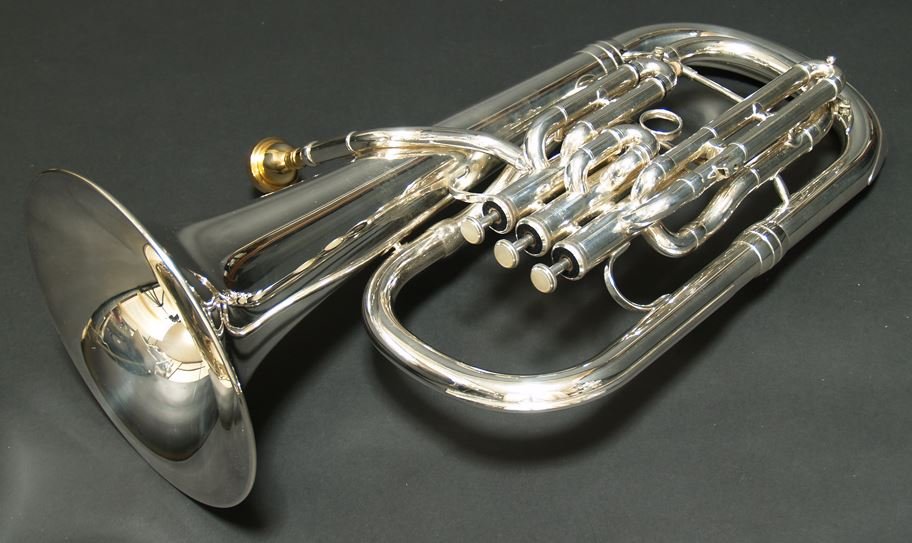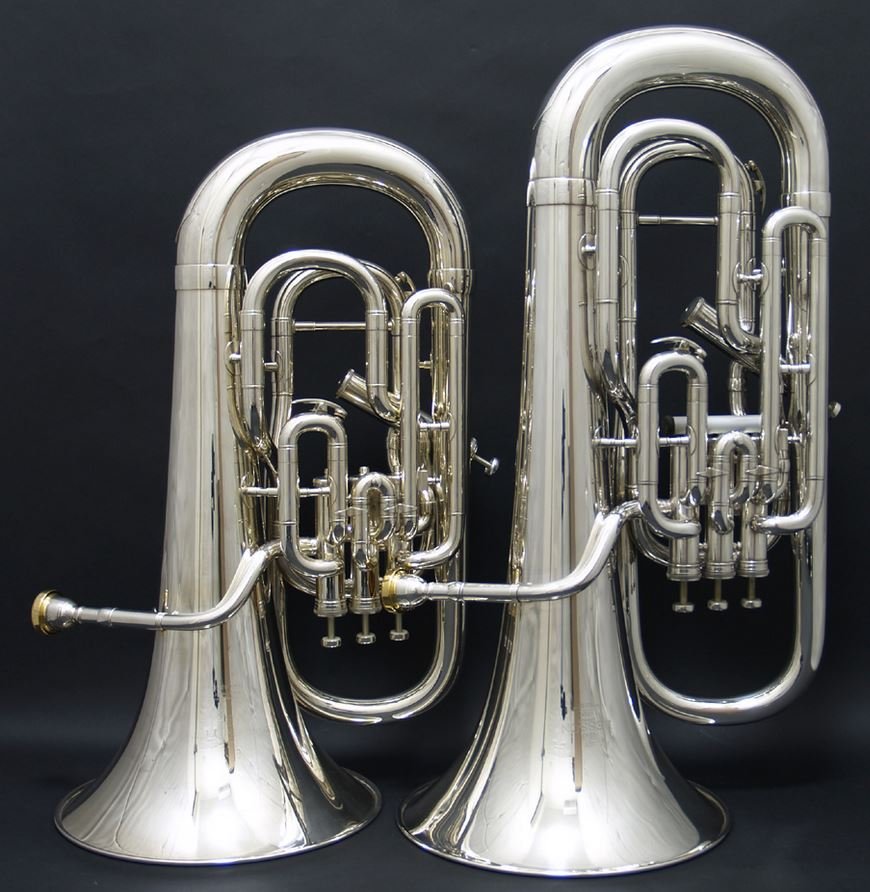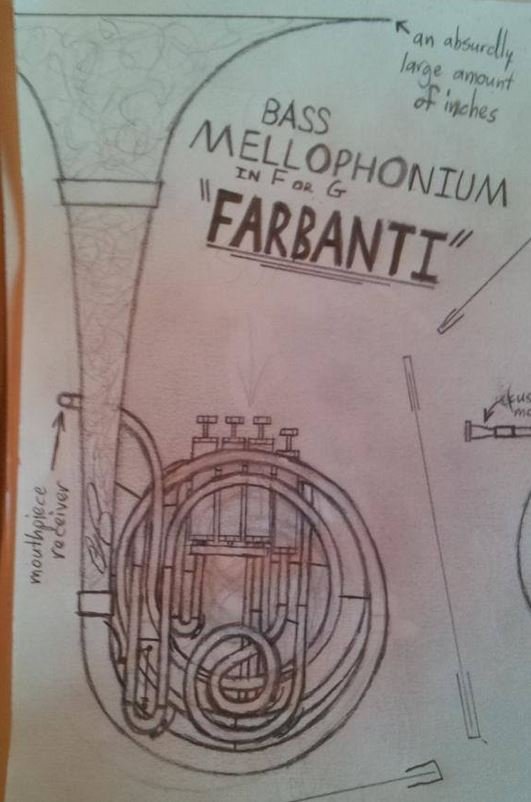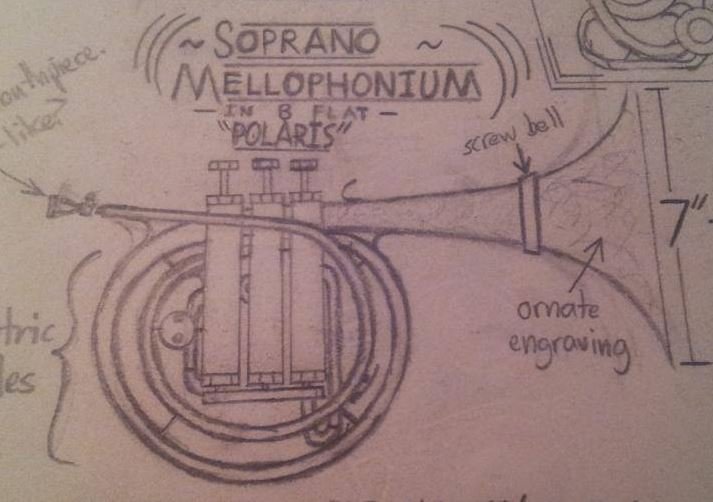Brass Instruments That Don't Exist (But Should)
It goes without saying (especially on this particular website) that there are a lot of brass instruments out there. Some probably shouldn’t exist, and others are probably not distinct enough to really deserve their own name. But they exist nonetheless, and going down the rabbit hole to discover and make sense of all of them is an endeavor that takes years.
But even though the concept of a mouthpiece attached to a metal cone has been tried hundreds or even thousands of ways, I believe we have not explored all that is possible in the brasswind medium. More to the point, I believe there are some brass instruments that should exist…but don’t. That’s what I’m going to discuss here, and hopefully inspire intrepid makers to make them a reality. (I can dream, ok?) Naturally, these are just my personal opinions, and if you have a different idea of a non-existent brass instrument that you wish was less non-existent, I’d love to hear about it.
Alto Euphonium
This might be the instrument I wish existed the most - a true F or E-flat alto tuba in the British euphonium style, with 3+1 compensating valves, a much larger bore and bell throat than an alto horn, and a small trombone mouthpiece shank. Technically, an alto euphonium does exist: the Yamaha YEH-901ST, which was made in a very limited (14 or 15) run in 1984-85 for Yamaha artists. It only had 3 valves, none of them have ever been for sale, and Yamaha no longer has the tooling to make any more. So although it technically does exist, practically speaking it might as well not. But this is the idea.
Yamaha YEH-901ST alto euphonium in E-flat (picture from Hidekazu Okayama’s website)
I plan to get an alto euphonium custom made for me from parts, as I really believe in its potential. Hopefully that project might inspire makers to give the concept a try. If my alto euphonium project is successful, I may then think about trying a soprano euphonium as well.
(Compensating) Euphonium in C
A similar (but less radical) instrument I’d like to see more of is a professional compensating euphonium in C. This did exist as the Besson BE765C, a special order instrument available until the company moved to Germany in 2006. That tooling is also likely long gone, and the picture below is the only evidence I have ever seen of the model. I can’t imagine more than a handful were ever made.
Besson BE765C-2 euphonium in C (left), Besson BE765-2 euphonium in B-flat (right). Picture from Hidekazu Okayama’s website.
C euphoniums do exist and are used in some parts of the world, but apart from the Besson above there are none that I know of that are British-style professional instruments. C tubas are a standard for orchestral tubists…I see no reason why a British-style compensating euphonium in C couldn’t also have merit, especially as a doubling instrument for tubists used to C fingerings.
6/4 American-Style Tenor Tuba
There have been some extra-large compensating euphoniums in the past, but what I’m proposing goes a step further. Massive 6/4 York-style C tubas are very much in vogue…why not try that same blueprint an octave up? Give it 4 front-action pistons with a 5th rotor and orchestral tuba players will flock to it as a doubling instrument even more than the C compensating euphonium mentioned above.
Bass Euphonium
I know what you’re thinking: “Isn’t a bass euphonium just an F tuba?” And I don’t blame you for thinking that, especially when small bell British F and Eb tubas that look and sound like big euphoniums exist. But my thought for an instrument called “bass euphonium” would be to take the dimensions of a modern compensating euphonium (.590” starting bore size) and use them to build an instrument in low G. The goal is an instrument somewhere in between a euphonium and bass tuba in sound. I will admit, this one isn’t that important to me, but I think it would be an interesting experiment. I have seen a few very small bass tubas for sale that have seemed like really good candidates to cut down into a bass euphonium. I’ve even seen a piston F tuba with a 12-inch bell!
Soprano Mellophone/Mellophonium
A custom Holton Bb soprano mellophonium, made from parts
A soprano mellophone in high B-flat is something I’ve wanted for a long time. A couple have been cobbled together from parts using trombone bells (see the above picture), but that’s not really the real deal. I’m talking new mandrels and tapers that match a modern mellophone, just a scaled down for an instrument a 4th higher. I would suggest still using a trumpet shank and the same bore size as an F mellophone, as you still want it to feel like a mellophone. Truthfully, I would love a soprano mellophonium with a .500” bore, the same as the Conn 16E mellophonium. But as no maker makes a bell-front mellophone that large anymore, you’d have to do that first and then make the high Bb version. Which…I would also welcome with open arms. I love my 16E, but that design leaves a ton of room for improvement by a modern maker.
Lower Mellophones
If the mellophone formula can be expanded upwards, why not downwards as well? I used to own a Conn 8E ballad horn from 1930, which is essentially a tenor mellophone in C or B-flat. But (to my knowledge) a modern bell-front tenor mellophone is not something that anyone has ever attempted. I even think a bass mellophone in F (an octave below the standard mellophone) would have a lot of potential.
I have been fascinated by the idea of a complete mellophone or mellophonium family for a long time, and even drew freehand sketches of what I would imagine some of the non-existent members could look like.
An old sketch of mine for a bass mellophonium in low F. I figured for an instrument of this length, an upright design was much more practical as a normal mellophonium is already an ergonomic challenge.
An old sketch of mine for a soprano mellophonium in high Bb.
I even sketched a little sopranino!
A Real Bass Horn
I’m not talking about the “bass horns” out there that are basically just rewrapped tubas. I’m talking about a proper double horn a 4th or 5th below a normal double horn, with a small bore proportionate to that of a normal horn, playable by a horn player or trombone/euphonium player, with a dedicated mouthpiece that’s a deep horn mouthpiece scaled up to around big alto horn (~19mm) or small trombone size. Much like modern descant horns usually use the same bells as double horns, the bass horn could use standard XL-throat double horn bells, like those from a Conn 8D or King Eroica.
Endangered Instruments
This category is for instruments that do exist, and you can even order them in some cases, but they are FAR too rare - often nearly impossible to find and/or prohibitively expensive. These are instruments that I would like to see someone step up and make more widely available. I think rare, odd instruments like these are the perfect specimens for Jinbao/Wessex/etc. to take on. They’ll be playable enough, but also affordable enough that many players can try them out, and maybe get a boutique maker to make them a better one if they like it enough. If you start with the ultra-expensive handmade custom horns, nobody will ever buy one and the market won’t materialize. But if you start cheap, it just might. Certainly, these instruments would make more sense and have more merit than some of the odd instruments Jinbao has chosen to clone.
Soprano flugelhorn (they are always in Eb, but I would love one in F as well)
Flugelhorn in C (with pistons and a 3rd slide trigger, just like a normal flugelhorn)
Martin-style jazz flugelhorn (the Miles Davis horn)
Alto flugelhorn (G, F, or Eb, a la the Couesnon)
Alto cornet (G, F, or Eb, a la the DEG model 1220)
Alto trumpet (G, F, or Eb)
Bass cornet (C or Bb)
Double trumpets (Bb/low F, Bb/high Eb, C/high F)
High F and G trumpets, especially with 4 valves
4-valve C and Bb trumpets
3-valve Bach-style piston bass trumpet in C (with main tuning trigger)
Contrabass trumpet (F or Eb)
British-style alto horn with 4 valves (most recent example: Kanstul ZAT-1540)
British-style 3+1 compensating baritone horn
Double bell alto horns, baritone horns, and tubas
British-style 3+2 non-compensating euphonium
Large bore (.500") soprano trombone (with valve and tuning-in-slide)
Large bore (.547”) alto trombone (with Bb valve, possibly tuning-in-slide)
Alto trombone in F
Alto valve trombone (F or Eb)
Large bore, bell-up trombonium (a la Conn 90G)
Bass trombonium (3 valves, in low F or E-flat)
Sopranino trombone in Eb
Tenor trombone in C
Tenor or bass trombone in Bb/F/ascending C
Double valve (Bb/F/Gb) tenor trombone (in .508”, .525”, and .547”)
Modern bass trombones in low G or F (hey pBone, please make a straight F bass. I’d love you forever)
G contrabass trombone (a la Jeff Reynolds)
Tuba-shaped F cimbasso (a la Kalison)
Tubas in G and D (G = shortened small F, D = shortened 4/4 rotary C)
Valved ophicleide (I would LOVE to try an F bass valved ophicleide in a brass quintet)
French ascending piston double horn (a la Selmer Thevet Ascendant)
Ascending double horns in general
Bass Vienna horn (F/C)
Other Pie-in-the-Sky Ideas (that I’m not actively hoping for, but would be fun)
Alto superbone
A superbone with 2 valves and a 4-position handslide, requiring you to use both in tandem constantly to play chromatically
New sizes of corno da tirarsi (slide horn), and corni da tirarsi with a valve or two
New sizes of Wagner tuba (alto in Eb, contrabass in C, high double in Eb/Bb, low double in F/C)
French ascending piston triple horn and double descant horn
Soprano trombones in G and C
Soprano valve trombone (in a shape and taper that distinguishes it from a trumpet)
3 and 4 valve trumpets (not alto trumpets, or soprano bugles) in G
Contrabass cornet in F or G
4-valve compensating flugelhorn
Tubas/euphs/baritones/tenor horns/cimbassos with echo bells (like an echo cornet)
A Bb contrabass trombone that doesn’t suck (the most unrealistic idea here)
Soprano Trombone
Do you want to buy a soprano trombone? Do you want to know why the soprano trombone exists? Do you want to explore the weird world of comically small trombones? If you answered “yes” to any of those questions, this article is for you.
The soprano trombone isn’t as endangered as most of the other instruments I write about on this site, and there is a good amount of information about it online. But I’ll start with a brief summary of what it is in case you’ve discovered it first through this article. If you read this and find that soprano trombone still isn’t small enough for you, I have another article on even higher trombones.
Thein soprano trombone
The soprano trombone is a trombone pitched one octave above the standard tenor trombone; in other words, it is pitched the same as a standard B-flat trumpet. It usually has a trumpet shank and can be played with a variety of mouthpieces. Nowadays you can buy extremely affordable Chinese soprano trombones from quite a few vendors, but almost nothing has ever been written for the instrument and professional-quality soprano trombones are very rare. Soprano trombones are sometimes referred to and marketed as slide trumpets; it’s easy to understand why, as the cheap ones are usually made with trumpet parts and they sound like trumpets when played with a trumpet mouthpiece. But the name “slide trumpet” was already taken by an interesting Renaissance trumpet variant centuries before anybody ever applied it to the soprano trombone, so it is better to avoid. Interestingly, in the early 20th century manufacturers sold both “slide trumpets” and “slide cornets”, the only difference being the mouthpiece shank.
Despite being a logical member of a very well-established instrument family, the soprano trombone has almost never been explicitly written for. There are good reasons for this, and good articles and academic publications have written at length about the subject (especially regarding early music). The only place where the soprano trombone gained a permanent foothold was in Moravian trombone choirs, whose core instrumentation was a large mass of trombones from soprano to B-flat contrabass. Even the German Posaunenchor ditches the soprano trombones for Kühlohorns (a variety of rotary flugelhorn) on the top parts, and most trombone choirs do not use anything above alto trombone at all. More recently, the soprano trombone has garnered some attention from its use in jazz by Wycliffe Gordon, but apart from this and the efforts of contemporary classical soloist Torbjörn Hultmark and avant-garde jazz soloist Steven Bernstein, the instrument remains essentially unused in any notable capacity.
In my opinion, there is a simple reason for this: nobody knows what mouthpiece to use for it.
Cheap Chinese soprano trombones always come with a generic 7C trumpet mouthpiece. This makes it sound like an out of tune trumpet and is not desirable. Wycliffe Gordon uses his own custom hybrid mouthpiece with a trombone rim and cup on a trumpet shank, but while you can order these from Chasons, they are very expensive. Someone interested in dipping their toes in the soprano trombone is not likely to want to spend $300 on a mouthpiece for it, especially if its only documented use is by Wycliffe Gordon, who is hardly a normal player like us mere mortals! As a result, the few who do buy soprano trombones typically don’t venture very far off the trumpet mouthpiece path.
I have long held my own theories about what the ideal soprano trombone mouthpiece would be, and I have been able to test some of these theories to favorable results. I used to own an extremely cool soprano trombone, which I have to share here:
This is a handmade German soprano trombone, with a rotor that has slides to put it in A, Ab, G, or F. The rotor is activated by an old-school leather strap rather than a modern paddle, and the bell has a kranz. There is no maker’s mark to be found, and it is likely an exam instrument made by a journeyman apprentice. It is impossibly cool, and I am so thrilled to have owned and played it. It’s gone now, in the hands of someone who will use it more than I did.
Now, on to the mouthpieces. I tried a fleet of mouthpieces on that soprano, to varying degrees of success. These are my findings:
Trumpet mouthpieces: it sounds like a trumpet. Very fun to play this way, and there are certainly musical uses for a trumpet that can do true glissandos and other slidey things, but the goal here is to get a proper trombone sound that fits perfectly on top of alto and tenor trombones. For that, trumpet mouthpieces are not the way.
Bach 9AT alto trumpet mouthpiece: I always thought this would be the solution, but thanks to its oversized shank (it is not just a normal trumpet shank!), it does not work very well in the soprano. It does get an amazing beefy trombone sound, but it is very difficult to play high on, so much so that it offers no real improvement in range over an alto trombone.
Schilke 24 trumpet mouthpiece: This is a massive trumpet mouthpiece, somewhere in between any normal-sized trumpet mouthpiece and the Bach 9AT above (inner diameter 18.29mm). I thought it might do well, but it ended up being nearly as hard to play as the 9AT but with a thinner sound. Not the move.
Denis Wick 2 alto horn mouthpiece: even harder to play on than the 9AT, which is not surprising as the DW 2 is the biggest alto horn mouthpiece Denis Wick makes. It is BEEFY.
Kelly 3W alto horn mouthpiece: the Kelly is a deeper British-style alto horn mouthpiece like the Wick 2, but it is significantly lighter (being plastic) and is not as large or deep. The result works well in the soprano. The tone is nice and dark, with a trombone-like broadness. Range is good too, with a comfortable range up to Bb5. It still feels too deep both from a sound and effort perspective, but it doesn’t feel too far off the mark for a broad classical soprano trombone sound. The alto horn-sized rim also feels right for instrument, and my bass trombonist face certainly appreciates the additional room.
Marching mellophone mouthpieces: I tried 3 of my marching mellophone mouthpieces (Hammond 5MP, Benge Mello 6V, CKB Mello 6) and they all worked about as well. These get a bright sound that is definitely not the right move for classical playing, but for playing jazz on top of small tenor trombones the sound feels just about perfect. There is lots of snap and sizzle to the sound, but it is still much fatter and noticeably more trombone-like than with a trumpet mouthpiece. Articulations also sound like a trombone rather than a trumpet, and the range is unaffected with an easy C6.
Holton 55 alto horn mouthpiece: after my experiences with all of the above, I had postulated that an American alto horn mouthpiece with a shallower bowl cup might be the perfect solution. So far, I think my hypothesis was on the money. It has a nice fat tromboney sound like the bigger options above, but I can still play comfortably up to around high Bb and it works nicely all over the horn without too much effort (unlike any of those others).
Although I still have not tried every possible kind of mouthpiece yet, I feel that I’ve found a solid formula for both sound and playability that gives the instrument a unique trombone voice: American alto horn mouthpiece for classical, marching mellophone mouthpiece for jazz. That said, there are a few more options I still have to explore the next time I own a soprano:
German flugelhorn mouthpiece - German flugelhorns use a shank essentially identical to a trumpet shank, so you can use them on anything with a trumpet shank (like soprano trombone). German flugelhorn mouthpieces are also generally not quite as deep as the dark, rich Denis Wick-style flugelhorn mouthpieces, nor are they as shallow and thin as Bach-style bowl cup flugelhorn mouthpieces. It could be a really nice middle ground that would mesh well with the soprano trombone, and given the history of rotary flugelhorns being used in their place, it seems like it would be a good fit.
Curry TF/ACB FX - these hybrid trumpet mouthpieces with deep flugel-like cups are an interesting option. I’m not very confident that they would be the right move, but considering how well the marching mellophone mouthpieces work I could be wrong.
Chasons hybrid trombone/trumpet mouthpiece - this is the kind of mouthpiece Wycliffe uses on soprano trombone. While I would love to try one of these, they are very expensive and I’m not motivated to spend that kind of money on a possible soprano trombone mouthpiece!
As you can see, I didn’t quite complete my soprano trombone mouthpiece safari. But I did get some excellent results that gave the instrument a proper soprano trombone voice, and I would encourage other soprano trombone owners to expand your horizons beyond trumpet mouthpieces to get the most out of your instrument.
Of course, there is also the question of what soprano trombone to buy if you don’t already have one. Fortunately, there are not too many choices to be confused by and I’ll give you a quick summary of each.
Cheap Chinese sopranos - if you just want a soprano to mess around with for fun or to see if you have any interest in pursuing the instrument further, this is the tier you should be looking at. There are a million different brands, but you should ignore them all and buy the Thomann SL-5. Why? Because they are all the exact same instrument, and the Thomann is the cheapest by a significant margin. It’s VERY cheap, so if you really want a soprano and don’t want to budget very much for it your search ends here. Even used Chinese sopranos cost more than this.
Jupiter 314 - this was the most popular entry-level soprano when it was in production, as it came before all the cheap Chinese ones. They are no longer made, but you can find them used occasionally for around the same price as most new Chinese sopranos ($200-300). The Thomann is still much cheaper, but you probably won’t get a bad example with a Jupiter and it will hold its value better.
Carol Brass CTB-1005-YSS-Bb-L - In addition to being made by the good maker that is Carol Brass, the CTB-1005 is superior to any cheaper soprano for one big reason. All the Chinese sopranos and the Jupiter 314 are tuned via the tenon attaching the bell to the slide, which is the cheapest and worst method. The CTB-1005, on the other hand, has proper leadpipe tuning like a flugelhorn. As far as affordable sopranos go, it is far and away the best option. Its price varies depending on the retailer; it lists at $479 at Carol Brass of the Rockies, but $900 at Austin Custom Brass.
Carol Brass CTB-2005-GLS-GL - Carol’s mind-numbing alphanumeric naming scheme makes it seem like this should be a simple variation of the above soprano trombone, but this is actually a completely new model, recently introduced. Notably, it is pitched in G rather than B-flat! It uses the bell (including that big shepherd’s crook) from the maker’s Phat Puppy flugelhorn, and does sound much more flugel-like than most soprano trombones. A very interesting new development for the soprano!
Carol Brass CTB-2005-GLS-GL soprano trombone in G - see the full product page here
Miraphone 63 - this is the only factory professional-level soprano trombone on sale today. I haven’t played one so I don’t know how well it plays, but at $2300 this is really only an option to the most dedicated players.
Thein - this is probably a soprano that is really worth the money, but it is a LOT of money. If you absolutely must have the very best soprano money can buy, this is your ticket.
Custom - honestly, if you have a tech you trust and access to a cornet bell and a small bore trombone slide, I would rather get one custom made than buy a cheap factory instrument. You can make it whatever bore you want, whatever mouthpiece shank you want, add a valve if you want, and so on. It will probably play at least as well as a new Chinese instrument and be infinitely cooler.
Vintage Used - Occasionally, used sopranos from the early 20th century will turn up for sale online, often for prices in the new Chinese range. If they are in decent shape and going for the right price, they could be a good option. The one model I would avoid is the DEG/Getzen with the ultra-narrow handslide.
Minick - The famed brass maker Larry Minick made a few sopranos, including a few with valves for studio players. They are extremely rare today.
Wessex PB455 - The PB455 was a large bore (.500”) soprano with F attachment that Wessex only very briefly offered on their website. It was removed almost immediately due to quality issues. They sadly never fixed the issues and relaunched the product, though the owner of Wessex did tell me a few years ago that you could still custom order one if you wanted.
























